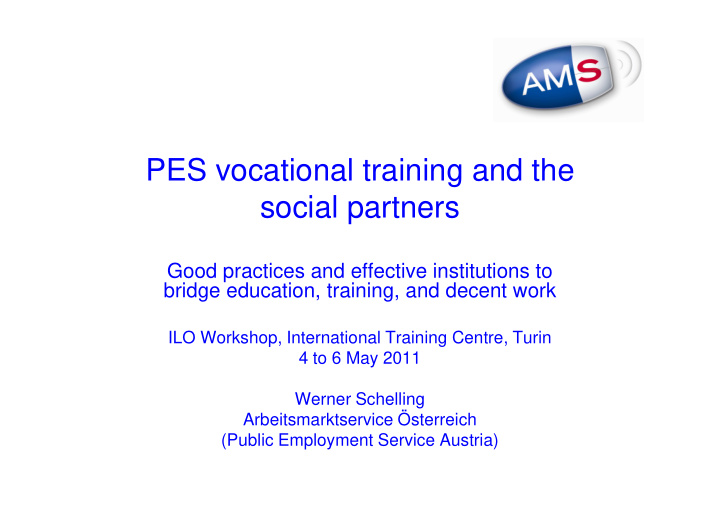



PES vocational training and the social partners Good practices and effective institutions to bridge education, training, and decent work ILO Workshop, International Training Centre, Turin 4 to 6 May 2011 Werner Schelling Arbeitsmarktservice Österreich (Public Employment Service Austria)
Overview of the labour market in 2010 (average stock) (% change compared to 2009 in brackets) � Dependent employees 3,360,238 (+ 0.6 %) � Unemployed total 250,782 (- 3.7 %) � Unemployed women 105,676 (- 1.0 %) � Unemployed women 105,676 (- 1.0 %) � Unemployed men 145,106 (- 5.5 %) � Unemployed youth 15 to 24 40,084 (- 6.6 %) � Unemployed > 45 84,971 (- 0.2 %) � Unemployed foreigners 48,167 (- 1.5 %) � Unemployment rate 4.4 % (- 0.4 %) � Unemployment rate EU 27 9.6 % (+ 0.6 %) 2
PES and vocational training � PES is one of the big players in vocational training (for unemployed and for employed persons) � No PES training institutes, all measures are outsourced � Expenditures 2010: € 687 million (€ 625.5 million national funds, € 61.5 million European Social Fund – national funds, € 61.5 million European Social Fund – ESF) � 63.7 % of total expenditures for active labour market policies of € 1,079 million � 345,803 persons (78.7 % of all persons who took part in active mesures) 3
Role of social partners (1) � All PES vocational training programmes are approved by the social partners � The social partners operate some of the biggest vocational training institutions � They are treated by the PES as any other provider: they � They are treated by the PES as any other provider: they have to take part in tenders 4
Role of social partners (2) � The social partners are involved in strategic decisions on all levels of the PES organisation: � Federal level � Regional level � Local level � Local level � Social partners: � Chamber of Labour � Federation of Trade Unions � Economic Chamber � Industrialists‘ Association 5
Role of social partners (3) Examples of decisions in which the social partners are involved � Federal level � Long-term plan (regarding all aspects of the PES; 2009-2013) � Long-term plan (regarding all aspects of the PES; 2009-2013) � Annual budgets for staff, IT and material and for active measures � Allocation of staff to the regional organisations � Annual targets � Appointment of the Board of Directors and the Regional Directors 6
Role of social partners (4) � Regional level � Annual working programme � Regional targets � Allocation of the budget for active measures to the local offices � Allocation of staff to the local offices � Appointment of the Regional Directors � Local level � Mid-term working programme � Annual working programme � Local targets � Consultation before the appointment of the Regional Director 7
Role of social partners (5) � Advantages of involving the social partners in important decisions � Discussions on important labour market issues take place within the PES and not so much outside � All decisions are a compromise between employees‘ and employers‘ organisations and thus accepted by both employers‘ organisations and thus accepted by both � Decisions taken are widely accepted by the PES customers and the public � PES management and employees are rarely criticised in public by the social partners � Disadvantages � Sometimes it takes a long time to get a decision � Some decisions are not as clear (compromise!) as the PES management would like to have them 8
Cooperation with providers (1) � PES provides all basic services like counselling, acquisition of vacancies, job placement and granting of unemployment benefits through its own staff � All active measures are carried out by external providers � Counselling for special target groups (handicapped, etc.) � Counselling for special target groups (handicapped, etc.) � Job orientation courses � Activation courses � Basic vocational training measures for youth � Further vocational training measures � Employment measures � Business formation programme � Qualification and flexibilisation counselling for businesses 9
Cooperation with providers (2) � Procedure � Thorough analysis of the labour market � Design of measures according to the needs of the labour market and to the targets � Tender (national, regional) � Decision according to a points-based system (quality of the � Decision according to a points-based system (quality of the concept, quality of staff, gender mainstreaming, price) � Quality assurance measures � Monitoring of the results (integration of jobseekers into the labour market) � Revision of the design accordingly 10
Cooperation with providers (3) � Advantages of outsourcing active measures � PES can concentrate on its core business � PES must not provide staff and premises which might be used only for a few years � Competition among providers can produce better quality � Competition among providers can produce better quality � Problems with the current procedure of outsourcing � When price is weighted too high competition can produce low quality (low salaries for staff!) � The tendering intervals are too short: the local PES offices often have to become familiar with new partners (providers) which takes some time 11
Thank you for your attention! Thank you for your attention! 12
Recommend
More recommend